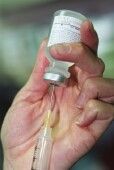Article
Oral Bisphosphonate Use Poses Risk of Wet Age-Related Macular Degeneration
Author(s):
Regular users of oral bisphosphonates had a higher risk of developing wet age-related macular degeneration than non-users, according to results of a recent Canadian study, and the longer the use, the greater the increased risk.

Bisphosphonates, which are typically used to prevent osteoporosis, are some of the most prescribed drugs. They are known to increase the risk of inflammatory eye diseases such as scleritis, uveitis, and optic neuritis, and their pro-inflammatory properties may account for this increased risk as well as the flu-like symptoms that have been reported as adverse effects of their use.
The appearance of flu-like symptoms after use of the injected bisphosphonate zolendronic acid (Reclast/Novartis) has been attributed to the release of inflammatory mediators such as C-reactive protein. This common marker of systemic inflammation has been associated with coronary artery disease and implicated in the development of age-related macular degeneration (AMD), including its neovascular (wet) form.
Although epidemiologic studies have revealed that smoking and obesity are risk factors for AMD, the effects of chronic use of pro-inflammatory drugs like bisphosphonates on the risk of AMD were unknown. To determine whether regular, long-term use of oral bisphosphonates increases the risk of AMD in older adults, a team of Canadian researchers did a series of three epidemiologic studies whose results were reported jointly in the American Journal of Ophthalmology.
Results were obtained in part from disproportionality analysis of data from the U.S. Food and Drug Administration (FDA) Adverse Event Reporting System (AERS), which does not distinguish between wet and dry AMD. As a result, the population of the first study included all patients who had been taking oral bisphosphonates who were newly diagnosed with any form of AMD and whose cases were reported via the AERS from Q4 of 2004 to Q2 of 2014.
The report also included results from two studies of data on wet AMD collected from British Columbia Ministry of Health Databases: a case-control study and a self-controlled case series (SCCS).
The population for these two studies included all patients who received a first injection of an anti-vascular endothelial growth factor (VEGF) agent (mostly bevacizumab [Avastin/Roche] or ranibizumab [Lucentis/Roche]) for wet AMD in British Columbia from 2009 through 2013. The population for the case-control study included one million controls from data collected in British Columbia from 2000 through 2007.
Analysis of AERS data showed that regular use of oral bisphosphonates posed a risk of any form of AMD and that this association increased with increasing years of use. All of the agents studied were associated with this increased risk. However, for all cases studied, alendronate (Fosamax/Merck) had a higher association than risedronate (Actonel/Warner Chilcott), which had a higher association than ibandronate (Boniva/Genentech).
The case-control study showed an increased risk of wet AMD with increasing duration of bisphosphonate use. For example, the adjusted odds ratio for risk of wet AMD requiring anti-VEGF injection was 1.24 (95% confidence interval [CI] 1.12—1.38) after 1 year of regular bisphosphonate use and 1.59 (CI 1.38–1.82) after ≥3 years of regular use.
The SCCS produced findings similar to those of the case-control study. Rate ratios for risk of wet AMD requiring anti-VEGF injection increased from 1.22 (CI 0.76—1.95) after 1 year of bisphosphonate use to 1.87 (CI 1.32–2.67) after 5 years of use. Rate ratios did not differ for men and women.
Taken together, these findings indicate that physicians should be particularly alert to the possibility of any AMD, and especially the wet type, in older adult patients who have vision problems and who are regular users of oral bisphosphonates.
2 Commerce Drive
Cranbury, NJ 08512
All rights reserved.



